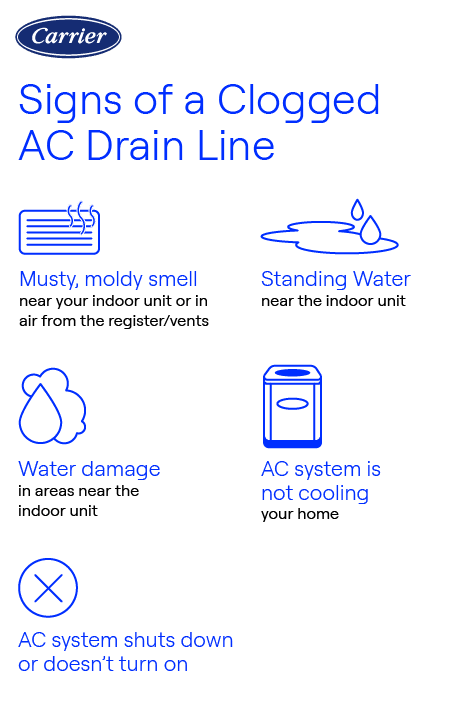How to Clean AC Drain Line
While it may be temping to buy your own AC drain line cleaner, be sure to contact a qualified HVAC technician when you see signs of a condensate drain pipe clog to prevent serious damage to your AC system or your home. A clogged AC drain line is a fairly common cause of system malfunction, and unclogging an AC drain line is often an easy issue to fix for a qualified HVAC contractor.
Also, you might be interested in visiting our air conditioner repair page for additional information regarding how you can help ensure that your AC works as intended and potentially reduce the risk of other future system issues.

Signs of An AC Drain Line Clogged

As indoor air circulates through the evaporator coil, dust, dirt and other airborne particles can be trapped by moisture. Build-up of this debris can be carried off as condensate drains from the coil. Over time, it can become trapped in your condensate drain line, causing blockage. As a preventative measure, many HVAC technicians will inspect and clear debris from the AC condensate drain during your annual AC maintenance tune-up. If this service isn’t done regularly, you could potentially experience an AC drain line clogged.
A clogged AC drain line symptoms include:
- Musty, moldy smell near your indoor unit or in air from the registers/vents
- Standing water near the indoor unit
- Water damage in areas near the indoor unit
- AC system is not cooling your home
- AC system shuts down or doesn’t turn on
If you experience any of the above situations, it’s probably time to contact an AC drain line cleaner who knows how to clear a clogged air conditioner drain line.

How To Unclog AC Drain Line
Here’s what to expect when your HVAC tech arrives to fix an AC drain line clogged. AC service is best handled by a qualified professional who has the tools and experience necessary to unclog an AC drain line.
Step 1 - Power Off the Air Conditioning Unit
When your HVAC services professional arrives to check your clogged AC drain line, they will likely turn the system’s power off, even if it is already not running. This is for the safety of the technician as well as to protect the HVAC system from additional condensate-related damage.
Step 2 - Check the Drain Pan
One of the first things the technician will do is locate the drain pain and check for standing water. If standing water is present, it can either be soaked up with rags or removed with a wet vac. The dry condensate pan should be thoroughly cleaned to help prevent the growth of mold.
Step 3 - Unclog the Clogged Condensate Drain Line
After physically removing any visible debris from the AC drain or drain pipe opening, the most likely way the technician will clear the clogged AC drain line is using suction from a shop vacuum or wet vac. Alternatively, they might use a garden hose or plumbers snake to remove the clog. If successful, they should find a dark mass that was suctioned or pushed out of the drain line when they check the vacuum. They might also test that the line is clear by pouring a small amount of clean water through the drain and observing its ability to flow out.
Step 4 - Clean the Drain Line
Once the AC drain line has been unclogged, the technician will likely follow up with a thorough cleaning of the drain pipe using a commercially available cleaner designed for use on PVC piping. If you ask, the technician may show you how you can pour a cup of a mild cleansing agent like distilled vinegar to occasionally give the drain a cleaning yourself between routine maintenance calls.
Step 5 - Finish Up
Once the drain has been cleaned and tested, your technician will reassemble or reinstall any parts removed, restore power to the system and check to be sure everything is functioning properly.
Find an AC Drain Line Cleaner To Help With Clogged AC Drain Line
If you have a situation with a clogged air conditioner drain line and you have exhausted the AC troubleshooting steps outlined previously, it’s time to schedule an appointment with a certified AC drain line cleaner. Your local Carrier HVAC dealer offers the expertise needed to properly diagnose and service your clogged AC drain line.
Contact a Carrier HVAC Dealer keyboard_arrow_right

Frequently Asked Questions On Clogged AC Drain Lines
Yes, a clogged AC drain line can cause the air conditioner not to work properly. When the drain line is clogged, water cannot escape from the condensate pan. Water may overflow from the pan, potentially causing water damage and triggering a safety switch that shuts down the system. The system may not operate efficiently if the condensate pan is full.
- Find out How Do Air Conditioners Work
- Wondering "What Size Air Conditioner Do I Need?"
- Learn about Air Conditioner Coil Cleaning
- Factors and variables - "How Long Do Air Conditioners Last?"
- Why is my AC Fan Not Working?
- Why you should get an AC Tune Up

